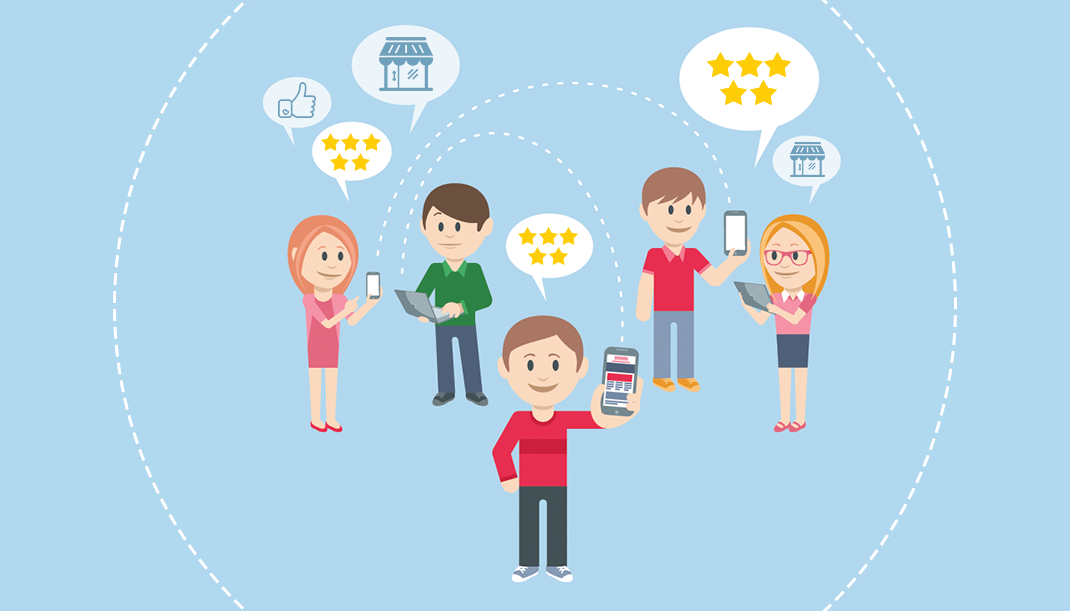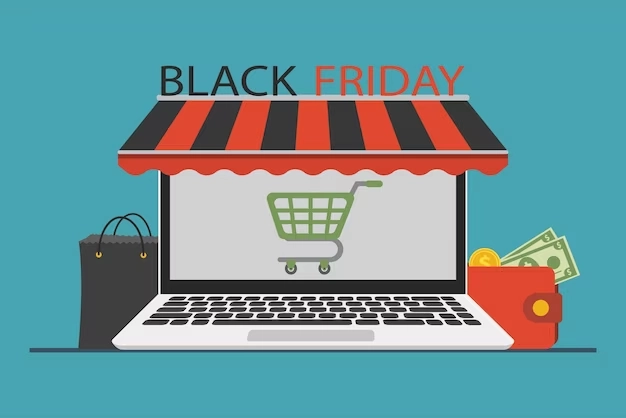Loss Aversion Marketing For E-Commerce: How To Use It To Maximize Your Sales
An old proverb says: a bird in the hand is worth two in the bush.
We are sure the person who said it was certainly afraid to experience the suffering of loss. Well, that is not surprising, as all people hate losses. In fact, this is an integral part of human behavior.
It has been found that the psychological pain of losing is two times more than the power of gaining. So you might think, why are we talking psychology now?
Well, psychology can not be separated from marketing. You can understand human behavior through psychology, which reflects in your marketing efforts.
By analyzing human behavior, it turned out that just the idea of loss is enough to make people take the desired action.
So, you should first consider loss aversion marketing for e-commerce. It is one of the most successful tactics you can leverage to drive more customers to your online store.
We are sure you are a little confused about how stressing the feeling of loss leads to gaining customers.
So, let us make things clear for you in this article. We will define loss aversion marketing for e-commerce and shed light on some strategies and examples.
Table Of Content
- What Is Loss Aversion Marketing For E-commerce?
- Strategies For Loss Aversion Marketing For E-commerce
- Examples On Loss Aversion Marketing For E-commerce
What Is Loss Aversion Marketing For E-commerce?
Theoretically, loss aversion is a psychological phenomenon in which losses are more painful and given more weight than gains.
In other words, loss aversion is the discomfort a person experiences when facing losses. Hence, it is argued that loss aversion is the difference between potential benefits and expected losses. Accordingly, people might refuse benefits to prevent experiencing losses.
This is simply human nature. Humans weigh costs and benefits to avoid losses at all costs.
The success of any e-commerce occurs through linking loss aversion with marketing.
To incorporate loss aversion in marketing for e-commerce, you will have to portray the losses that customers will encounter if they do not buy your products. And since people don’t like losing, they will undoubtedly be more inclined to purchase your products to avoid losses.
Let us explain loss aversion marketing for e-commerce with an example: You are purchasing an online product and find a 50% sale on everything just for today. You would not want to miss this sale or lose not so little amount of dollars. Thus, you will instantly add products to your cart just to avoid the feeling of loss.
We are trying to show this in loss aversion marketing for e-commerce. You highlight the losses that might be encountered without pressing it too hard to avoid customer confusion and anxiety.
Strategies For Loss Aversion Marketing For E-commerce
Now that you understand what is loss aversion marketing for e-commerce. We will tell you some strategies you can use to ace loss aversion marketing.
1- Coupons
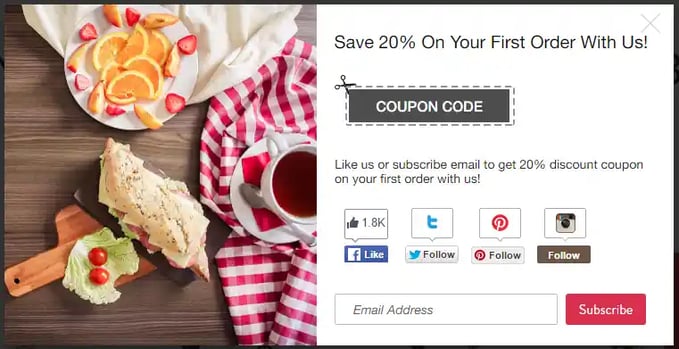 Image source: beeketing.com
Image source: beeketing.com
You can first rely on coupons to showcase loss aversion marketing in e-commerce. Online shoppers don’t do anything to receive coupons. Therefore, customers perceive them as a jackpot.
The significance of coupons lies in being valid for a limited time. Accordingly, customers are encouraged to use the coupon to avoid losing value.
You have to ensure that the offer granted by your coupon is too good not to be used. Hence, you have to highlight the gains offered by the coupon while at the same time highlighting the loss they will acquire if they do not redeem it.
Just highlighting the right amount of loss with the right amount of gains will be perfect.
2- Discounts
To reinforce loss aversion, you can rely on the classic old school by offering discounts.
Discounts and sales encourage online shoppers to place a purchase. It is better to show the product's price before and after the discount. This will make customers realize they are losing a great deal that can’t be missed.
Thus, they will be motivated to order products without losing extra cash.
3- Cart Abandonment Emails
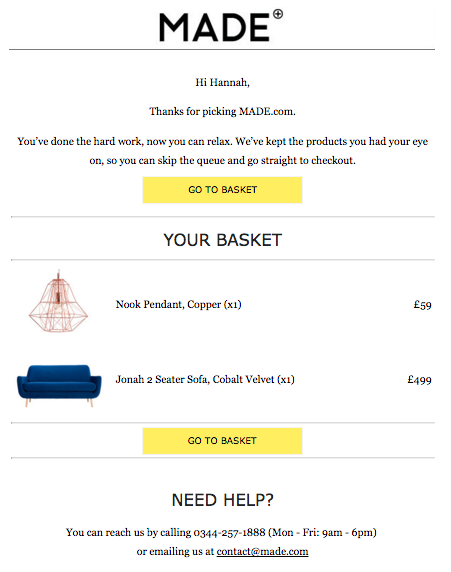
Does an online shopper really want to lose the gorgeous pink dress she just added to her cart? We are confident she does not.
The shopper does not want to lose the product in the cart, and you, as an online store owner, want her to return her abandoned product. So, why not ignite loss aversion marketing and make it a win-win?
This can be done through cart abandonment emails. You can send customers who abandoned their carts personalized emails reminding them of what they are about to lose if they continue to abandon their carts. Also, you can show that the product might go out of stock soon.
In addition, you can offer them free shipping if they complete their order. This is something they wouldn't want to lose.
Speaking of email marketing, we understand that you might struggle to handle your email campaigns. Therefore, we recommend using ConvertedIn.
Convertedin is a marketing automation tool that builds and customizes email marketing campaigns tailored to your marketing activities. Email marketing will be done effortlessly while ensuring an accelerated ROI.
Seriously, do you want to lose all of these benefits Convertedin offers? (We think we just nailed using loss aversion marketing).
4- Pre-Order Deals
Pre-order deals are bonuses, discounts, and coupons that customers acquire when they place an order before launching. Additionally, customers can receive exclusive new items by pre-ordering.
Pre-order deals usually expire on the day of the launch. Hence, they are one of the most winning loss aversion marketing strategies for e-commerce.
Online stores stress loss aversion by highlighting that missing pre-ordering will lead to losing exceptional deals that won’t be repeated.
Ignoring pre-ordering as a customer, you will lose the finest offers offered by your favorite brand.
5- Leverage FOMO Marketing
 Image source: trustmary.com
Image source: trustmary.com
FOMO marketing is a key tactic businesses use to encourage customers to make purchases, or they will miss out on something great. Hence, it is a feeling of anxiety and regret someone gets when they feel they are missing out on something.
FOMO marketing is a psychological phenomenon you can use in loss aversion marketing for your e-commerce. In fact, FOMO marketing should be incorporated into all of your loss aversion marketing strategies.
This can be done in three ways:
- Urgency: Through urgency, you will force customers to leave everything behind to place an order in your online store, or else they will miss out and lose a considerable offer.You can display urgency by using phrases like “limited-time offer” or “flash sale,” or you can place a countdown.
Simply, you have to put a time frame for your offers so customers become in a hurry to purchase.
- Scarcity: Scarcity can be enforced by highlighting the levels of your stock. Therefore, you can show when your stock is running out or when a few items are left.
- Social Proof: Social proof is a psychological phenomenon that indicates that people tend to seek others’ confirmation and imitate them.
Social proof can be done through several practices. For instance, you can share customers’ feedback and testimonials, use expert testimonials or show the number of people who trusted your brand and placed orders.
By using various social proof practices, you can build customers’ trust. Accordingly, people will be more inclined to imitate others by purchasing your products, or they will lose the amazing products you are offering.
Examples On Loss Aversion Marketing For E-commerce
To prove the viability of loss aversion marketing for e-commerce, we will show you some examples of online businesses taking advantage of such an influential marketing tactic.
1- Amazon

The e-commerce giant understands the vital role of loss aversion in driving more sales. Therefore, Amazon leverages loss aversion through different means.
For example, on its product page, Amazon emphasizes the discount customers receive by purchasing the product. For instance, in the picture above, the most highlighted numbers are not the product prices but the discount percentage.
Accordingly, people are more encouraged to pay so they don’t miss such a huge discount.
Also, Amazon creates flash sales to create urgency. In addition, it places a countdown for the ending time for the deal of the day.
2- Ghurka
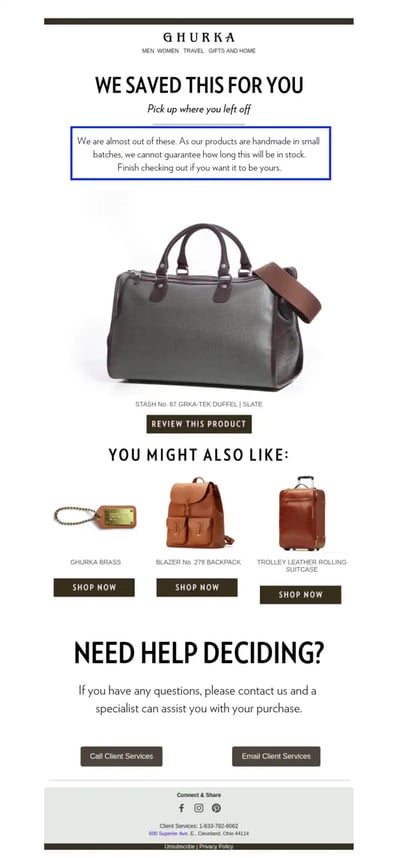 Image source: abtasty.com
Image source: abtasty.com
Ghurka is an online brand specializing in luxury leather goods and accessories. Ghurka perfectly understands how to excel in reinforcing low aversion marketing for its e-commerce.
To reduce cart abandonment, Ghurka sends personalized emails to its customers to remind them of their abandoned products. The significance of this practice lies in the message sent.
It combines urgency with scarcity with a clear call to action so customers will do nothing but make a purchase to avoid losing this catch offered by Ghurka.
We have to say, we are impressed.
3- ASOS
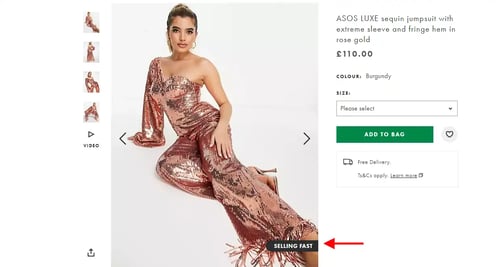 Image source: convertcart.com
Image source: convertcart.comASOS understands that online shoppers primarily focus on product images and nothing more than that.
Accordingly, to highlight scarcity, ASOS just adds a label if the chosen product is selling fast. They are just keeping things simple without being too pushy.
This simple label indicates scarcity and activates loss aversion. Hence, customers become more motivated to purchase.
Final Thoughts
Even though many marketers already practice loss aversion marketing for e-commerce, it still needs to be sufficiently used by online stores.
The power of psychological elements in your marketing efforts is capable of revolutionizing the performance of your online store. Therefore, if you still didn't include loss aversion marketing in your e-commerce, this is your sign to start doing it.
 By
By
